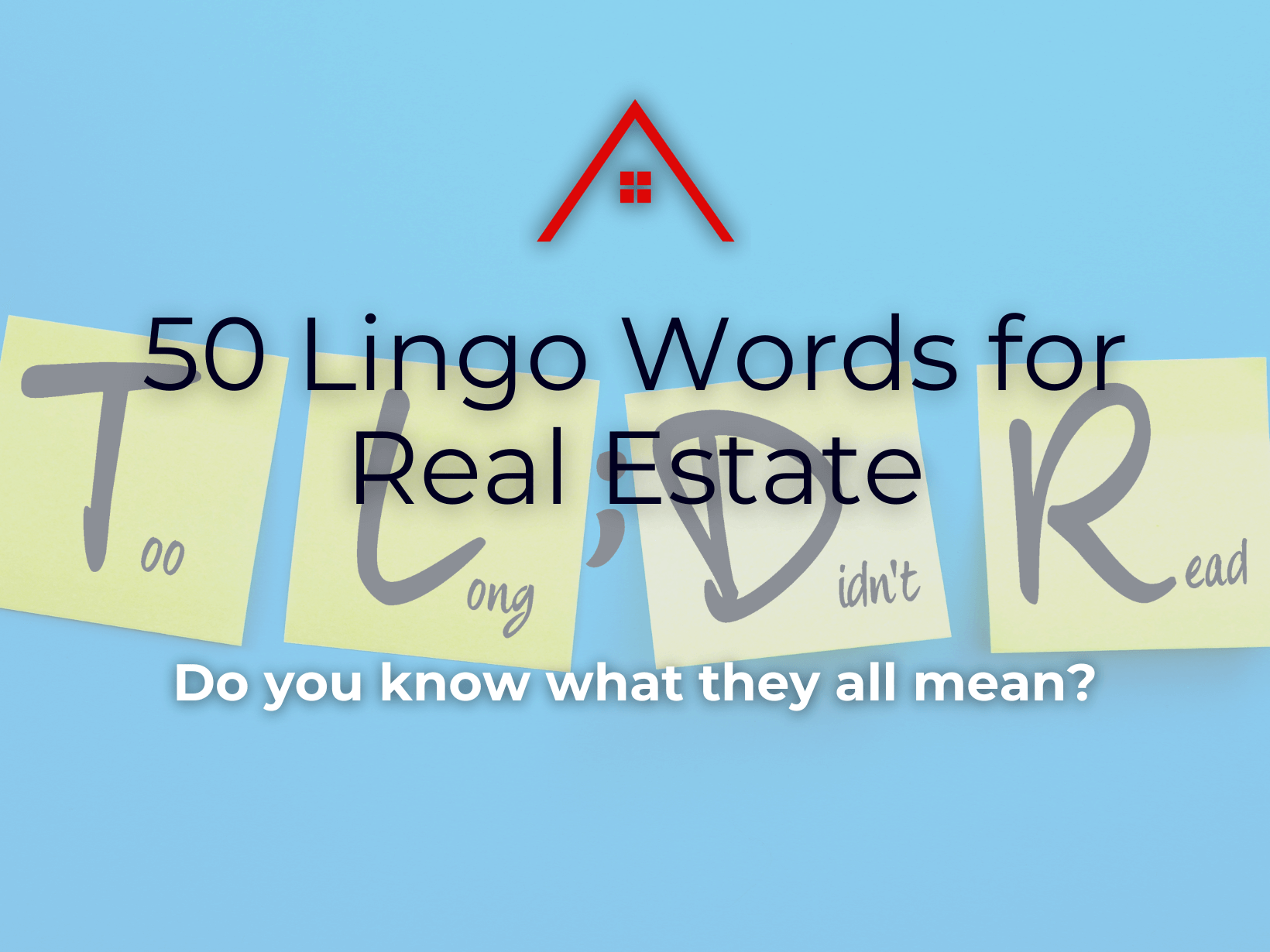This is kind of an odd article, but I work with plenty of new investors in Tampa. I thought I’d just list all the terms and jargon I know about real estate and investing. If you’re new(er), you’ll find this enlightening!
Be warned: it is a bit dry. Try searching for terms in my Blog to see if one exists without scrolling.
Looking for your next rental property in Tampa Bay and value my insight? You can schedule your initial conversation with me one on one below.
Learn the Lingo
-
Cap Rate (Capitalization Rate): A metric used to estimate the return on an investment property, calculated by dividing the property’s net operating income (NOI) by its current market value.
-
Cash Flow: The net amount of cash and cash-equivalents being transferred into and out of an investment. Positive cash flow indicates that a property’s income exceeds its expenses.
-
DOM (Days on Market): Refers to the number of days a property listing is active in the market before it is sold or taken off the market. It’s a key metric used in real estate to gauge the liquidity of a property and the overall demand in the housing market.
-
Cash-on-Cash Return: A rate of return on a real estate investment, calculated by dividing the cash income earned by the amount of money invested.
-
Depreciation: An income tax deduction that allows an investor to recover the cost of an asset over its useful life. In real estate, it refers to an annual deduction taken over the property’s estimated useful life.
-
Equity: The difference between the current market value of a property and the amount owed on its mortgage. Equity increases as the mortgage is paid down and/or the property value appreciates.
-
Leverage: The use of borrowed capital (debt) to increase the potential return of an investment. In real estate, it typically means using a mortgage to finance a portion of a property’s purchase price.
-
LTV (Loan-to-Value) Ratio: A metric used by lenders to assess the risk of a loan, calculated by dividing the mortgage amount by the appraised value of the property.
-
NOI (Net Operating Income): A property’s total income minus operating expenses, excluding financing costs and taxes. It’s a key metric to evaluate a property’s profitability.
-
Pro Forma: A projection of future financial performance based on assumptions about income, operating expenses, and occupancy rates.
-
REIT (Real Estate Investment Trust): A company that owns, operates, or finances income-producing real estate. REITs offer a way to invest in real estate without owning physical properties.
-
ROI (Return on Investment): A performance measure used to evaluate the efficiency or profitability of an investment, calculated by dividing the profit from an investment by its cost.
-
Vacancy Rate: The percentage of all available units in a rental property that are vacant or unoccupied at a particular time.
-
1031 Exchange: A provision in the U.S. tax code that allows investors to defer capital gains taxes on real estate by reinvesting the proceeds from a sale into a similar property.
-
BRRRR (Buy, Rehab, Rent, Refinance, Repeat): An investment strategy that involves purchasing a property, renovating it, renting it out, refinancing it to pull out investment capital, and repeating the process.
-
Due Diligence/Inspection Period: The comprehensive investigation and evaluation of a property before purchase, including legal, financial, physical, and other pertinent factors. This is a window of time where you can cancel the deal and retrieve your earnest money.
-
Escrow: A neutral third party or account that holds funds or assets until the completion of a specific condition or event in a transaction, ensuring a secure transfer.
-
Hard Money: A short-term loan secured by real estate, typically used by investors to finance property acquisitions and renovations. These loans have higher interest rates than traditional mortgages.
-
Wholesaling: A real estate investment strategy involving the contract to purchase a property with the intention to sell the purchase contract to another investor before closing, often without making any repairs.
-
Appreciation: The increase in the value of a property over time, which can result from changes in the market, development of the area, or improvements to the property.
-
Distressed Property: Real estate that is under foreclosure or being sold by the lender. Often, these properties are below market value, presenting potential opportunities for investors.
-
Amortization: The process of spreading out a loan into a series of fixed payments over time. In real estate, this refers to the method of paying off the debt on a property through regular principal and interest payments.
-
ARV (After Repair Value): The estimated market value of a property after it has been fully repaired and renovated. This figure is crucial for investors to calculate potential profits from fix-and-flip projects.
-
Closing Costs: Fees and expenses over and above the price of the property in a real estate transaction. These costs can include title insurance, loan processing fees, appraisal fees, and more.
-
Deed: A legal document that represents the ownership of a property. It is transferred from seller to buyer during the sale of the property, officially transferring ownership.
-
Lien: A legal right or claim against a property by a creditor. Liens must be paid off when a property is sold, and they affect the clear transfer of property ownership.
-
Market Value: The most probable price that a property should bring in a competitive and open market under all conditions requisite to a fair sale.
-
Non-recourse Loan: A type of loan secured by collateral, usually property, where the borrower is not personally liable. If the borrower defaults, the lender can seize the collateral, but cannot seek out the borrower for any further compensation.
-
Operating Expenses: The costs associated with running and maintaining a property and its rental operations. This includes property management fees, insurance, property taxes, repairs, and utilities. This does not factor in a mortgage payment.
-
PMI (Private Mortgage Insurance): Insurance that a borrower must purchase for the lender’s protection when the down payment on a mortgage is less than 20%. PMI is typically required on conventional and FHA loans.
-
Real Estate Owned (REO): Properties owned by a lender—typically a bank, government agency, or government loan insurer—after an unsuccessful sale at a foreclosure auction.
-
Refinancing: The process of replacing an existing mortgage with a new one, typically with better terms or to take out equity from the property.
-
Short Sale: A real estate transaction for the sale of a property for less than the amount owed on the mortgage. The lender must agree to this arrangement as they will receive less than the amount owed.
-
Title Insurance: Insurance that protects the buyer and lender against losses caused by disputes over the title of a property. It ensures that the seller has the legal right to sell the property.
-
Turnkey Property: A property that is fully renovated or in new condition and ready to be rented out immediately. Ideal for investors who want to avoid the time and expense of fixing up a property.
-
Zoning: Regulations established by local governments regarding the use of land and buildings. Zoning laws dictate how a property can be used, affecting its investment potential.
-
Capital Expenditure (CapEx): Major expenses incurred to increase the value or extend the life of a property, such as replacing the roof or HVAC system. CapEx differs from repair and maintenance expenses in terms of scale and investment purpose.
-
Debt Service Coverage Ratio (DSCR): A measurement of a property’s cash flow available to pay current debt obligations. It’s calculated by dividing the property’s net operating income (NOI) by its total debt service. Lenders use DSCR to assess a property’s ability to sustain its debt.
-
Value-Add Property: Real estate that has the potential to earn more income with improvements or better management. Investors target these properties for their potential to increase in value through strategic upgrades and operational efficiencies.
-
Rent Roll: A comprehensive document or spreadsheet containing all the critical details about the tenants and rental income of a property. It typically includes information such as tenant names, lease start and end dates, monthly rent amounts, security deposits held, and any other income derived from the property, like parking fees or service charges.
-
P&L (Profit and Loss) Statement: is a financial report detailing a company’s revenues, expenses, and profits over a specific period, showcasing its financial performance and profitability.
-
Net Sheet: A document provided to sellers in real estate transactions, estimating their net proceeds from the sale of a property after accounting for all costs, including closing costs, mortgage payoffs, and real estate commissions.
-
Due-on-Sale Clause: A provision in a mortgage contract requiring the borrower to pay the entire outstanding balance upon sale or transfer of the property. This prevents the new owner from taking over the existing mortgage.
-
Escalation Clause: A clause in a lease or purchase offer that allows for an increase in price or rent under certain conditions, often used in competitive bidding situations to outmatch other offers.
-
Fixture: Personal property that has been attached to land or a building and is now considered legally part of the real property. Fixtures include items like lighting systems or built-in cabinets.
-
Flood Zone: Not a complicated one. You’re either in one or out of one. You could have a flood zone on your land, but not on your house and you’ll still avoid higher insurance. Zone X means no flood zone. Zone A/AE are common around Tampa.
-
Wear and Tear: The inevitable physical deterioration of a property from normal use. Understanding what constitutes normal wear and tear versus tenant damage is crucial for handling security deposits and maintenance responsibilities.
-
Section 8: Refers to a government-funded program that provides rental housing assistance to low-income tenants. Landlords who participate can receive a portion of their rent directly from the government, ensuring a stable income source but also requiring compliance with specific regulations.
-
BPO (Broker Price Opinion): A real estate broker’s estimation of a property’s value. This is used instead of an appraisal in select situations.
-
CoC (Cash on Cash): A metric that measures the annual pre-tax cash flow of a property as a percentage of the total cash invested. Often more reliable to compare cash flow than cap rate.





